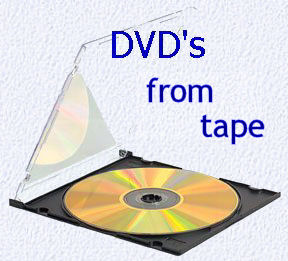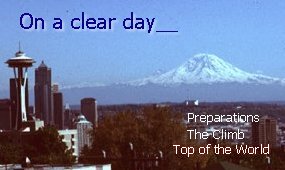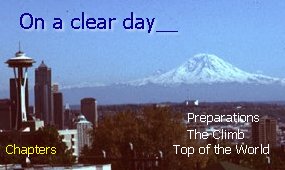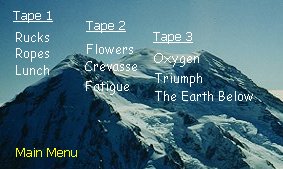

 |
|
|
|
||||||||||||||||||||||
We can also include 3-5 chapter stops on your menu, at no extra charge.
For example: you've brought in three thirty minute tapes to have transferred to DVD. You ask us to create a separate item in the menu -- a chapter stop -- for each of the three tapes.

Complex menus can also be created.
You may wish to be able to move through the segments of the DVD internally, the same way that you can jump from one track to another on a music CD. In order to do this, we must locate each point that you identify and "author" (create) a second menu, linked to the buttons on the first.
 |
 |
In the example above, clicking on any of the phrases in the menu on the left plays an entire tape. Clicking on the yellow "Chapters" button calls up the sub-menu to the right. In the sub-menu, each tape is divided into three chapters, which can be accessed randomly. There is also a button enabling return to the Main Menu.
The ability to create linked sub-menus is virtually limitless, making the DVD an excellent medium for training materials as well as for family tapes and for archiving materials such as photos, slides and film transfers.
Since authoring complex menus is time-consuming we charge at the tape editing rate of $80 per hour for this service. To keep costs down it is essential that you plan your chapter breakdown and linking carefully before bringing your tapes in to VideOccasions for transfer to DVD.
Be sure to consult with us regarding the numerous possibilities available for creating your DVD, from a simple title picture to more elaborate menus.
The region code for North America, Bermuda and the United States territories is 1. Although DVD players in Europe and parts of Asia can play multi-region discs, those in the United States are generally restricted to playing Region 1 encoding.
If you're planning on purchasing DVDs abroad, make sure they are encoded as Region 1 or Region 0 discs, the latter being a universal format that can be used in any DVD player.
VideOccasions is unable to make copies of DVDs other than those encoded for Region 1 or 0.
Understanding this distinction can prevent a lot of grief when you bring back discs from abroad and attempt to play them here in North America, or have VideOccasions convert your disc from PAL to NTSC.
What's the difference between DVD-R and DVD+R?
The following answer is quoted, in part, from the Answerbag web site:
"The truth is that the two competing technologies use different formats. No single company "owns" DVD and both technologies have their "champions". DVD-R/RW was developed by Pioneer [. . . and is ] supported by the DVD Forum, an industry-wide group of hardware and software developers, and computer peripheral manufacturers. . . DVD+R/RW is supported by Sony, Philips, HP, Dell, Ricoh, Yamaha, and others, and has recently been endorsed by Microsoft. . .
Technical Answer: DVD+R is a dvd disc that allows multiple layers for one disc where as DVD-R only allows one layer. . . Multi layer DVD+R can allow more capacity per disc than DVD-R . . . "
 |
Because of the difficulty some DVD players have in playing DVD+R discs, VideOccasions burns all DVDs on DVD-R discs. |
| Order Form for DVD Duplication |
Last updated 12/22/15